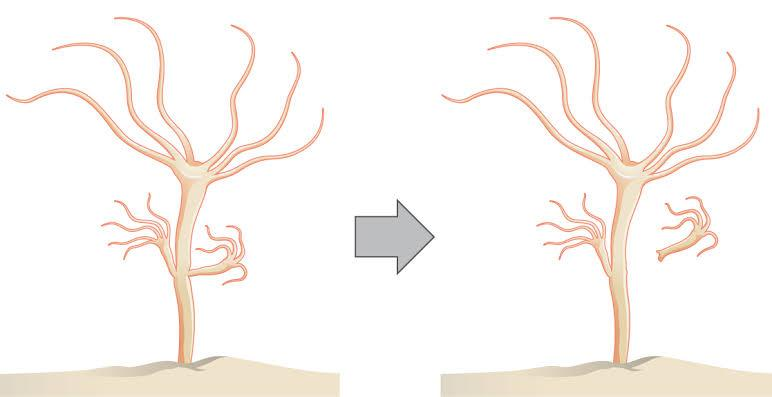
An organism which reproduces by budding is
A. Amoeba
B. Hydra
C. Plasmodium
D. Rhizopus fungus
Answer
568.8k+ views
Hint: Budding is a type of asexual reproduction . Some organisms reproduce in this manner in which small buds are produced from the parent cell, get separated, and mature into a new organism.
Step by step answer:Asexual reproduction is the method in which only a single parent involves. Note that it differs from sexual reproduction as the latter involves both parents. All the offsprings produced by asexual reproduction are not only identical to the parent, but also to one another. It is sexual reproduction that brings in variation to the offsprings. Examples of asexual reproduction are binary fission, budding, zoospore formation, conidia formation, and gemmules. Budding is the method in which several buds are formed on the parent cell or body. Note that this division is unequal. The bud which gets initially attached to the parent body eventually falls off and matures into a new organism. Budding is seen in yeast (Saccharomyces) and hydra. The fallen bud develops into a new organism. Amoeba reproduces by binary fission. In this process, a cell divides into two halves and each half grows into an organism. Most unicellular organisms undergo reproduction in this manner.
It is important to note that plasmodium, which is a protozoan, undergoes reproduction that has both sexual and asexual phases. Rhizopus fungi reproduce by the formation of spores.

Hence the correct option is B, Hydra
Note: Yeast is an unicellular fungus while most others are multicellular and filamentous. Yeast undergoes budding to produce offspring while most others reproduce by the formation of zoospores or by sexual reproduction.
Step by step answer:Asexual reproduction is the method in which only a single parent involves. Note that it differs from sexual reproduction as the latter involves both parents. All the offsprings produced by asexual reproduction are not only identical to the parent, but also to one another. It is sexual reproduction that brings in variation to the offsprings. Examples of asexual reproduction are binary fission, budding, zoospore formation, conidia formation, and gemmules. Budding is the method in which several buds are formed on the parent cell or body. Note that this division is unequal. The bud which gets initially attached to the parent body eventually falls off and matures into a new organism. Budding is seen in yeast (Saccharomyces) and hydra. The fallen bud develops into a new organism. Amoeba reproduces by binary fission. In this process, a cell divides into two halves and each half grows into an organism. Most unicellular organisms undergo reproduction in this manner.
It is important to note that plasmodium, which is a protozoan, undergoes reproduction that has both sexual and asexual phases. Rhizopus fungi reproduce by the formation of spores.

Hence the correct option is B, Hydra
Note: Yeast is an unicellular fungus while most others are multicellular and filamentous. Yeast undergoes budding to produce offspring while most others reproduce by the formation of zoospores or by sexual reproduction.
Recently Updated Pages
A man running at a speed 5 ms is viewed in the side class 12 physics CBSE

State and explain Hardy Weinbergs Principle class 12 biology CBSE

Which of the following statements is wrong a Amnion class 12 biology CBSE

Two Planoconcave lenses 1 and 2 of glass of refractive class 12 physics CBSE

The compound 2 methyl 2 butene on reaction with NaIO4 class 12 chemistry CBSE

Bacterial cell wall is made up of A Cellulose B Hemicellulose class 12 biology CBSE

Trending doubts
What are the major means of transport Explain each class 12 social science CBSE

Which are the Top 10 Largest Countries of the World?

Draw a labelled sketch of the human eye class 12 physics CBSE

Explain sex determination in humans with line diag class 12 biology CBSE

Give 10 examples of unisexual and bisexual flowers

State the principle of an ac generator and explain class 12 physics CBSE




